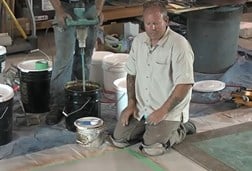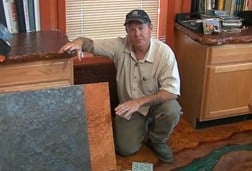- Countertop Tools
- Pouring & Finishing
- Coloring Tools
- Overlay Tools
- Polishing Tools
- Saws & Engravers
- More Concrete Videos
- Floor Videos
- Countertop Videos
- Outdoor Living Videos
- Furniture Videos
- Demonstration Videos
- Concrete Tool Videos
- Concrete Stain Videos
- Sealer Videos
- Concrete Stencil Videos
- Concrete Stamps Videos
- Surface Preparation Videos
- Concrete Forms Videos
Resurfacing & Overlay Tools Videos
Click below on one of the resurfacing and overlay concrete videos. Get Bob Harris' training book or dvd about concrete overlays and toppings.
Antique Spray for Stamped Concrete
Time: 01:48
An antiquing spray is made by adding a pigment to a liquid release agent to add variegated color to newly stamped concrete. See antique spray being applied to a stamped concrete overlay, and gets tips for proper application.
Applying a Microtopping
Time: 04:57
A cement-based microtopping can be used both indoors and out to provide a clean canvas for decorative treatments. The key to success is the proper surface preparation and applying the overlay at the right thickness. See the tools and techniques to use to apply a squeegee-grade microtopping.
Applying a Skim-Coat Overlay
Time: 07:32
A skim coat, or cement-based topping, is ideal for use on existing concrete surfaces where a clean canvas is needed. The key to success is the proper surface preparation and applying the overlay at the right thickness. Harris shows the tools and techniques to use for mixing the skim coat, blending in color, roller application, and final troweling.
Applying a Stampable Overlay
Time: 06:23
Cement-based stampable overlays can be applied at thicknesses ranging from ¼ to ¾ inch, creating a nice build that permits stamping and texturing. They can be used for numerous applications including floors, basements, pool decks and driveways. Harris demonstrates the tool and techniques for mixing the overlay components, preparing and priming the substrate, applying the overlay at the right thickness, and trowel finishing.
Stampable Overlay Coverage Rates
Time: 01:08
A stampable overlay, applied at a thickness of 3/8 inch, will typically provide a coverage rate of 13 to 14 square feet per bag. Get tips for estimating how much material you will need so you don't run out.
Texturing Stampable Overlays
Time: 05:46
Harris takes you step-by-step through the process of stamping an overlay, including applying a liquid release agent for easier stamp removal, using texture skins to pretexture the edges, stamp layout and placement (using a serpentine cobblestone pattern), and using a tamper to press the stamp firmly into the surface. He also discusses the best time for stamp removal, how to finish the edges, and how to tint the overlay for an antiquing effect.
When Is Your Overlay Ready to Stamp?
Time: 01:47
Jobsite conditions, such as temperature and humidity, will often dictate when your overlay is ready to stamp. Harris explains how to conduct a finger test to access the stage of plasticity so you stamp at the right time.
Turbo Roller
Time: 03:32
See how to properly use a Turbo Roller for applying cementitious microtoppings on interior concrete floors. This tool serves two basic functions. First, it pushes the microtopping, an overlay applied ¼ inch thick or less, across the surface spreading the topping over all areas of the floor. Second, the depth of the ridges on the roller determines the thickness at which the microtopping is applied. It is important to get the material down quickly after it has been mixed. Using the turbo roller helps ensure that your overlay is applied at a uniform depth across all areas of the floor.
Mixing Paddles
Time: 05:00
Learn how to select the proper type of mixing paddle and drill based on the material you are mixing. For small batches of epoxies or polyurethanes, use a small power drill. With cement-based mixes, use a larger, industrial ½-inch drill. Materials should be mixed at a variable speed no higher than 650 RPM. If the material is mixed any faster it can trap air in the mix and result in air bubbles in the mix. Harris also explains various other types of paddles to use depending upon the type of material being mixed, and demonstrates proper use of the paddles.
Hopper Spray Gun
Time: 04:08
Spray-on concrete toppings are applied using a hopper gun. The cement-based topping will be sprayed down with the hopper gun. Once the material is sprayed on the concrete surface, a technique called a knock-down-finish is done. This is done with a standard concrete pool trowel to flatten the bumps left by the spray. Make sure the hopper (material canister) is in an upright position to prevent leakage. The settings on the tip of the gun can be adjusted based on the amount of material you want to be applied. Spray-on toppings are often applied on pool decks because they provide a slip-resistant finish.
Magic Trowel and Squeegees
Time: 03:50
Learn the proper application techniques for applying concrete resurfacing materials with the Magic Trowel and squeegees. There are several tools used to apply concrete toppings including rubber squeegees, hand trowels, or metal squeegees. This demonstration video highlights how these tools function in the microtopping overlayment process. The Magic Trowel is used to create a smooth, glass-like, surface when applying the microtopping to a smaller area. Larger squeegees should be used for applying material to floors with thousands of square feet. Be sure you use the tool you are most comfortable with.
Gauge Rake & Smoothing Paddle
Time: 05:22
Gauge rakes and smoothing paddles are used when applying cement-based toppings or overlays. There are a wide range of choices for gauge rakes, so find out what your topping manufacturer recommends. The gauge rake helps lay down a cementitious material at a uniform thickness. A gauge rake should have rounded edges to ensure that the bonding primer that is often required will not be punctured. After using the gauge rake, use the smoothing paddle to smooth out the overlay's surface. Consider using a paddle with rounded corners, to avoid leaving ridge lines in the surface. Another way to avoud lines is to run your smoothing paddle in a perpendicular pattern to the way you gauge raked the surface. When smoothing, overlap your passes by 3 to 4", be sure not to press down too hard, and try to maintain the overlay's uniform depth.
Knee Pads & Respirators
Time: 02:03
It is important to follow the proper safety guidelines on the job. Be sure you always have the proper knee protection and respirators. Using knee pads will extend your concreting career as well as help prevent the need for knee surgery later in life. There are a number of knee pads and respirators to choose from. Perhaps the most important factor in selecting a respirator is making sure it is OSHA approved. Secondly, be sure that the respirator is the right one for the job you're doing. For example, if you are working on a job with only airborne dust particulate (fractured concrete in the air), you will need a different respirator than if you are applying a concrete dye that has chemical vapors. The cartridge on the respirator should indicate its proper use. If the cartridge says "chemical cartridge," it can be used when spraying products like acetones, xeylene, or acids.
Notch Squeegee & Porcupine Roller
Time: 04:17
Tips on using a squeegee and spiked roller for applying epoxy floor coatings to concrete floors. Squeegees are a simple way to smooth out the epoxy coating at a uniform depth. The notches in the rubber squeegees come in variable depths according to the thickness you want the epoxy coating applied at. The deeper the notches, the thicker the coating will be. Industry standard for the thickness of an epoxy coating is 10 millimeters thick up to around 30 or 40 millimeters thick. Once you squeegee on the epoxy, back roll the coating with a typical roller to smooth out the surface. The spiked roller is used after the coating has been applied to pop any out-gassing bubble, commonly referred to as fish eyes.
Choices in Garage Floor Coatings
Time: 05:51
Harris discusses some of the options available when it comes to choosing a decorative garage floor coating, including epoxy color chip systems (with color chips broadcast into an epoxy base) and metallic epoxies, which have a textured, hammered-metal look. He also talks about what it takes for successful installation, including proper substrate preparation, testing the existing floor for moisture content, and protecting the coating with a clear finish.



















